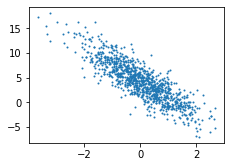线性回归tensorflow实现
xiaoyao 《动手学深度学习》 tensorflow2.1.0
import tensorflow as tf
print(tf.__version__)
# from Ipython import display
from matplotlib import pyplot as plt
import random
%matplotlib inline
import warnings
warnings.filterwarnings('ignore')
2.1.0
3.2.1 生成数据集
利用tensor和GradientTape实现一个线性回归的训练
设训练集样本数为1000, 特征数为2. 给定生成的批量样本特征
X
∈
R
1000
×
2
boldsymbol{X}inmathbb{R}^{1000times 2}
X∈R1000×2,使用线性回归模型真实权重为:
w
=
[
2
,
−
3.4
]
boldsymbol{w}=[2, -3.4]
w=[2,−3.4]和偏差
b
=
4.2
b=4.2
b=4.2,以及一个噪声项
ϵ
epsilon
ϵ来生成标签:
Y
=
X
w
+
b
+
ϵ
(式1)
boldsymbol{mathcal{Y}}=boldsymbol{X}boldsymbol{w}+b+epsilontag{式1}
Y=Xw+b+ϵ(式1)
其中噪声项
ϵ
epsilon
ϵ服从均值为0,标准差为0.01的正态分布。噪声代表了数据集中无意义的干扰。
num_inputs = 2
num_examples = 1000
true_w = [2, -3.4]
true_b = 4.2
features = tf.random.normal((num_examples, num_inputs),stddev = 1)
labels = true_w[0] * features[:,0] + true_w[1] * features[:,1] + true_b
labels += tf.random.normal(labels.shape,stddev=0.01)
features[0], labels[0]
(<tf.Tensor: shape=(2,), dtype=float32, numpy=array([-1.1710224, 1.3963023], dtype=float32)>,
<tf.Tensor: shape=(), dtype=float32, numpy=-2.8871787>)
这里,features的每一行是长度为2的向量,而labels的每一行是长度为1的向量(标量)
print(features[0], labels[0])
tf.Tensor([-1.1710224 1.3963023], shape=(2,), dtype=float32) tf.Tensor(-2.8871787, shape=(), dtype=float32)
"""
生成第二个特征features[:,1]和标签labels的散点图,这里可以更加直观的反映出
两者之间的线性关系
"""
def set_figsize(figsize=(3.5, 2.5)):
plt.rcParams['figure.figsize'] = figsize
set_figsize()
plt.scatter(features[:, 1], labels, 1) # 0设置为透明,1设置为不透明
<matplotlib.collections.PathCollection at 0x246120031c8>

3.2.2 读取数据
在每次训练模型的时候,需要遍历数据集同时需要不断读取小批量数据样本。定义一个
函数,每次返回batch_size(批量大小)个随机样本的特征和标签。
def data_iter(batch_size, features, labels):
num_examples = len(features)
indices = list(range(num_examples))
random.shuffle(indices)
for i in range(0, num_examples, batch_size):
j = indices[i: min(i+batch_size, num_examples)]
yield tf.gather(features, axis=0, indices=j), tf.gather(labels, axis=0, indices=j)
batch_size = 10
for X, y in data_iter(batch_size, features, labels):
print(X, y)
break
tf.Tensor(
[[-1.6544346 -0.21689671]
[-1.9006996 -0.60220146]
[ 0.47630018 0.16197595]
[ 0.6305033 0.06080767]
[-0.38096488 -0.72073525]
[-1.8225852 0.7859634 ]
[ 2.5961044 2.010577 ]
[ 0.23788874 -0.70898366]
[ 1.5793388 -0.97015315]
[-2.655049 -0.67389566]], shape=(10, 2), dtype=float32) tf.Tensor(
[ 1.6189524 2.4591262 4.5916023 5.2634425 5.903998 -2.1094294
2.5460227 7.093977 10.664606 1.1736389], shape=(10,), dtype=float32)
3.2.3 初始化模型参数
将权重初始化为均值为零,标准差为0.01的正态分布随机数,偏差初始化为0
w = tf.Variable(tf.random.normal((num_inputs, 1), stddev=0.01))
b = tf.Variable(tf.zeros((1,)))
3.2.4 定义模型define model
# 利用矢量计算表达式实现,使用tf.matmul函数做矩阵乘法
def linreg(X, w, b):
return tf.matmul(X, w) + b
3.2.5 定义损失函数define loss
# 这里需要将真实值y变形reshape成y_hat的形状。此函数返回的结果将和y_hat的形状
# 一致
def squared_loss(y_hat, y):
return (y_hat - tf.reshape(y, y_hat.shape)) ** 2 /2
# tf.reshape(tensor, shape, name=None) 函数说明
3.2.6 定义优化算法define optimization
"""
实现小批量梯度下降。通过不断迭代模型参数来优化损失函数,这里自动求梯度模块
计算得来的梯度是一个批量样本的梯度和,将其除以批量大小来得到平均值。
"""
def sgd(params, lr, batch_size, grads):
"""Mini-batch stochastic gradient descent."""
for i, param in enumerate(params):
param.assign_sub(lr * grads[i] / batch_size)
3.2.7 训练模型training
在每次迭代中,根据当前读取的小批量数据样本(特征x和标签y),通过调用反向函数t.gradients计算小批量随机梯度,同时调用优化算法sgd迭代模型参数。由于之前设置的批量大小为batch_size为10,每个小批量的损失l的形状为(10, 1)。
由于变量l不是一个标量,所以这里调用reduce_sum()将其求和得到一个标量,再运行t.gradients得到该变量关于模型参数的梯度。每次更新完参数之后将参数的梯度清零。
在一个迭代周期(epoch)中,我们将完整遍历一遍data_iter函数,并对训练数据集中所有样本都使用一次(假设样本数能够被批量大小整除)。这里的迭代周期个数num_epochs和学习率lr都是超参数,分别设3和0.03。在实践中,大多超参数都需要通过反复试错来不断调节。虽然迭代周期数设得越大模型可能越有效,但是训练时间可能过长。
lr = 0.03
num_epochs = 3
net = linreg
loss = squared_loss
for epoch in range(num_epochs):
for X, y in data_iter(batch_size, features, labels):
with tf.GradientTape() as t:
t.watch([w,b])
l = loss(net(X, w, b), y)
grads = t.gradient(l, [w, b])
sgd([w, b], lr, batch_size, grads)
train_l = loss(net(features, w, b), labels)
print('epoch %d, loss %f' % (epoch + 1, tf.reduce_mean(train_l)))
epoch 1, loss 0.033065
epoch 2, loss 0.000111
epoch 3, loss 0.000050
# 训练完成之后,可以将学习到的参数和用来生成训练集的真实参数进行比较
true_w, w
([2, -3.4],
<tf.Variable 'Variable:0' shape=(2, 1) dtype=float32, numpy=
array([[ 2.000201 ],
[-3.4001694]], dtype=float32)>)
true_b, b
(4.2,
<tf.Variable 'Variable:0' shape=(1,) dtype=float32, numpy=array([4.199146], dtype=float32)>)
最后
以上就是美丽抽屉最近收集整理的关于线性回归tensorflow实现的全部内容,更多相关线性回归tensorflow实现内容请搜索靠谱客的其他文章。








发表评论 取消回复